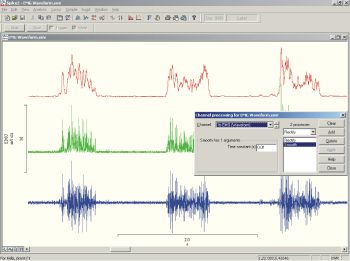Data processing
Spike2 contains advanced features for processing waveform and timestamp data. Waveforms can be modified and information passed between channel types, for example marking times of detected waveform features or converting event data to waveform for analysis of frequency content.
Channel processes
A channel process is an operation applied dynamically to waveform data. Although the original data is not changed in any way, the user sees the processed data. Multiple processes can be applied and removed at any time - see a video demonstration
- Processes include rectify, smooth, DC remove, slope, time shift, downsample, interpolate, match channel sample rate, median filter and RMS amplitude
- Apply processes on-line or off-line
- Duplicate channels for simultaneous display of raw and processed data

EMG data with duplicated channels showing
rectification and smoothing
Digital filtering
Digital FIR (Finite Impulse Response) and IIR (Infinite Impulse Response) filters can be applied to waveform data. Both types are set up using interactive dialogs with the following functions:
- View filter response and preview effect before applying filter
- Save and restore filters for later use
- Drag filter features or edit filter values
FIR filter types include high pass, low pass, band pass and band stop (1, 1½ and 2 bands) and differentiators with control of band edges and steepness of cutoff. FIR filters are unconditionally stable and impose no phase delay, so peaks and troughs do not move when data is filtered.
IIR filter types include notch and resonator filters plus low pass, high pass, band pass and band stop, modelled on Butterworth, Bessel and Chebyshev analogue filters. IIR filters allow steeper edges and narrower notches than FIR filters for the same computational effort.

Digital FIR filtering
Spike2 includes a number of channel processing options that can be applied to waveform or RealWave data channels. Channel processes are dynamic and do not affect the data stored on disk, but use the raw data to display a calculated version of the processed trace on-screen. This video tutorial shows how to apply channel processes to different types of data.
Registered in England: 00972132
Registered office:
- Cambridge Electronic Design Limited,
- Technical Centre,
- 139 Cambridge Road,
- Milton,
- Cambridge CB24 6AZ
- ENGLAND.
VAT: GB 214 2617 96
Producer registration number: WEE/BD0050TZ
For our US customers, we can provide tax form W-8BEN, that identifies us as a UK company.
UEI : EQ4LMQ1M2ZS5
CAGE/NCAGE: KB797
NAICS: 423490
Hardware: 84716070
Software: 85235190
By email:
By post:
- Cambridge Electronic Design Limited,
- Technical Centre,
- 139 Cambridge Road,
- Milton,
- Cambridge CB24 6AZ
- ENGLAND.
By telephone:
(Int.+44) (0)1223 420186
From North America (Toll Free):
1 800 345 7794








